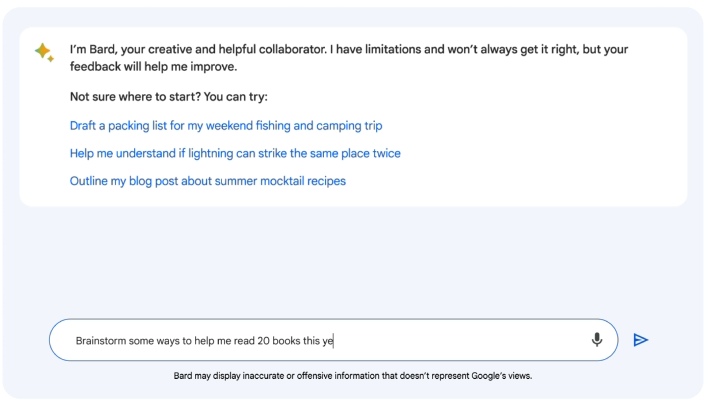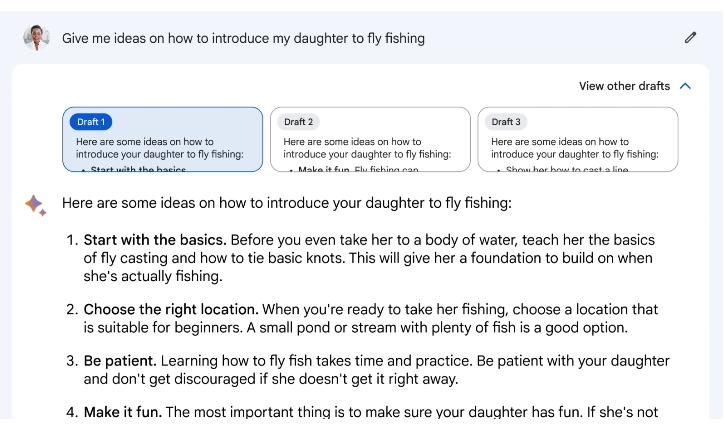Introduction
Have you ever wished you had a smart and friendly collaborator who could help you with any task or question? Someone who could give you tips, explanations, suggestions, or outlines for anything you want to do or learn? Well, now you can have one, thanks to Bard AI, a new experiment by Google that lets you collaborate with generative AI.
In this article, we will show you how to sign up and get started with Bard AI, how it works and what it can do, and some of the benefits and challenges of using generative AI. We will also share some examples of how Bard AI can help you with different tasks and questions. Let’s dive in!
What is Bard AI?
Bard AI is an experiment by Google that lets you collaborate with generative AI. It is a chatbot tool that uses a large language model (LLM) to generate responses to your prompts. You can ask Bard anything, from how to read more books this year, to what quantum physics is, to how to write a blog post. Bard will give you multiple drafts of its response, so you can pick the best one for you.
Bard AI is designed to supercharge your information, boost your productivity, and bring your ideas to life. You can use Bard AI to learn new things, explore new domains, and spark your creativity. Bard AI is powered by a lightweight and optimized version of LaMDA, Google’s large language model that can converse on any topic. Bard AI is also grounded in Google’s understanding of quality information.
Bard AI is currently available in the U.S. and the U.K. and will expand to more countries and languages over time. You can sign up to try Bard AI and share your feedback with Google
How Bard AI Works and what it can do
Bard AI is powered by a large language model (LLM) called LaMDA, which stands for Language Model for Dialogue Applications. LaMDA is a lightweight and optimized version of Google’s research LLM that can converse on any topic. LaMDA was trained on a large corpus of text from various sources, such as books, Wikipedia, news articles, and web pages.
You can think of an LLM as a prediction engine. When given a prompt, it generates a response by selecting, one word at a time, from words that are likely to come next. Picking the most probable choice every time wouldn’t lead to very creative responses, so there’s some flexibility factored in. We continue to see that the more people use them, the better LLMs get at predicting what responses might be helpful.
Bard AI is not just a search engine or a personal assistant. It’s a creative and helpful partner that can supercharge your information and creativity. You can use Bard AI to learn new things, explore new domains, and spark your creativity. You can ask Bard anything, from how to read more books this year, to what quantum physics is, to how to write a blog post. Bard will give you multiple drafts of its response, so you can pick the best one for you. You can also ask follow-up questions or have Bard try again if you want a different answer.
Some of the benefits and challenges of using generative AI
Generative AI has many potential benefits for individuals and society. It can:
– Enhance human productivity and creativity by providing new ideas, insights, and solutions.
– Accelerate innovation and discovery by enabling faster prototyping, testing, and iteration.
– Empower people to express themselves and communicate better by generating high-quality content in various forms and languages.
– Educate and entertain people by creating engaging and personalized learning and entertainment experiences.
However, generative AI also poses some challenges and risks that need to be addressed. It can:
– Produce inaccurate, misleading, or false information while presenting it confidently.
– Reflect real-world biases and stereotypes that are present in the data it was trained on.
– Generate harmful or offensive content that violates ethical or legal norms.
– Mislead or manipulate people by impersonating or spoofing others.
It is important to use generative AI responsibly and ethically, with awareness and caution. Some of the best practices for using generative AI include:
– Verifying the source and quality of the data used to train the generative AI model.
– Providing clear attribution and disclosure of the generative AI outputs.
– Applying appropriate safeguards and filters to prevent or detect harmful or offensive content.
– Seeking human feedback and evaluation to improve the generative AI model.
Thoughts
Generative AI has many potential benefits for individuals and society, but it also poses some challenges and risks that need to be addressed. It is important to use generative AI responsibly and ethically, with awareness and caution.



